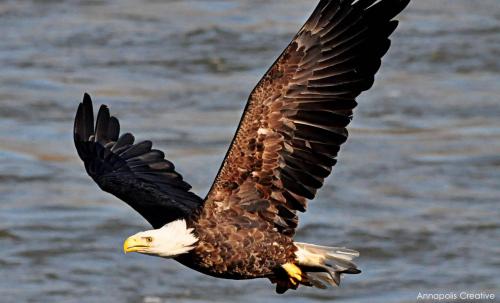By Donna L. Cole
Here it is – my final, guest blog post for Four Rivers Heritage Area about migratory birds. For the grand finale, I want to focus on my favorite bird, which in this area might not migrate at all, but we’ll get to that in a minute. First, you should know why it’s my favorite. This is a bird I never once, not once, saw in my youth or in most of adult years, up until around five or six years ago. Now – today, in the year 2016, this is a bird that my daughter has seen so much, she gives them the same amount of interest as she does to squirrels. And yes, maybe that’s a teenager for you, but this bird is seen so often by us, around this area, and the entire Chesapeake Bay watershed, they’ve become – well, kind of common. Hard to believe. Imagine, if you will, a bird that was on the brink of extinction, one you would never see, except on money, statues and photographs, to that same bird today – which has become yes, a common sighting to those of us who look up a lot. This is an extraordinary bird, with an even more extraordinary tale. This is our national bird.
Let’s talk bald eagles. How did bald eagles disappear and how did they make such a comeback? There was habitat loss of course, but we also used a pesticide called dichlorodiphenyltrichloroethane (DDT) and we used it liberally and frequently. DDT adversely effected eggs of bald eagles and other birds to the point of greatly limiting or eliminating the possibility of hatching. In 1962, a woman named Rachel Carson published a book called, Silent Spring, which warned of the dangers of DDT. That book was the game changer, which led to the eventual ban of DDT in this country and the comeback of bald eagles (and other wildlife). Now, you can maybe understand how for someone born in the 1960s, who wouldn’t have ever seen bald eagles, because this was the time of DDT – in fact, even for years after its use, was still the time of the lingering effects of DDT, would be so completely awe-struck at the first sighting of a bald eagle, they became her favorite bird. And yes, I’ll always remember that first sighting – not one, but two bald eagles along the Severn River.
The bald eagle will, because of freezing temperatures and water, migrate south. As their food, such as fish, becomes more difficult to get, the birds go to areas where it’s easier – where temperatures aren’t as extreme. Because we happen to be in an in-between zone of sometimes freezing and sometimes not, there are bald eagles who stay here year-round. For states south of us, the same goes. And every year, more and more bald eagles are being seen – it’s so very cool to watch the numbers and sightings continue to go up and up. History is changing before our very eyes.
Where can you see bald eagles? Just look up – seriously. There’s a pair I frequently see flying above Solomons Island Road, most often in between Lee Airport and the Annapolis Harbour Center. There are many (yes, many) near the confluence of the North and South rivers – two friends in recent history have reported seeing bald eagles doing Route 50 fly-overs where it crosses the South River. I’ve also seen bald eagles at Quiet Waters, Sandy Point and London Town. If you want to drive a little farther, the Eastern Shore is loaded with them. For guaranteed sightings, head to Conowingo Dam, which is best late fall to early winter.
What can you do to help these birds continue to flourish? If you’re a hunter and/or angler, switch to lead-free ammunition / tackle. And for everyone, please don’t use poison baits for rodents. Bald eagles are raptors and will eat whatever they can find, including poisoned carcasses, which kills them too.
I highly recommend this video (in other words, you absolutely, positively have watch this video) – https://vimeo.com/73593168
Images: top, juvenile bald eagle; bottom, mature bald eagle. Credit: Donna L. Cole, Annapolis Creative





